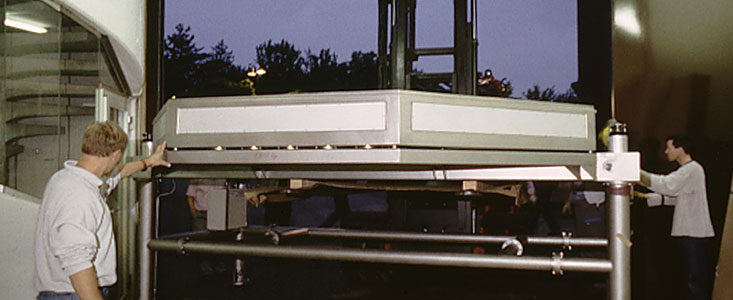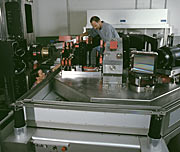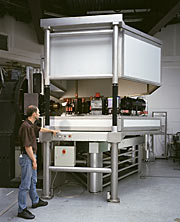Pressmeddelande
Large VLT Spectrograph Being Assembled
UVES at ESO Headquarters
7 september 1998
Following FORS and ISAAC , the first two major VLT instruments to be installed at Paranal (cf. ESO PR Photos 30a-e/98 ), more instruments will soon be added. Good progress is being reported, as the very comprehensive complement of VLT instruments is now constructed at various sites in Europe.
Following FORS and ISAAC, the first two major VLT instruments to be installed at Paranal (cf. ESO Press Photos eso9837), more instruments will soon be added. Good progress is being reported, as the very comprehensive complement of VLT instruments is now constructed at various sites in Europe.
Among these, the UV-Visual Echelle Spectrograph (UVES) will be the third instrument to be installed at Paranal. While FORS and ISAAC go to the UT1, UVES is the first instrument at the UT2, the second telescope of the VLT array.
UVES will add significantly to the scientific capabilities of the VLT. When it becomes available for visiting astronomers in somewhat over one year from now, it will allow observations of even quite faint objects at very high spectral resolution. High-resolution spectroscopy is indeed a "photon starved" discipline that demands much light and it will thus especially profit from the much increased photon collection area of the VLT as compared to 4-m class telescopes.
Among the main astronomical goals with UVES are studies of the intergalactic gas from the absorption spectra of very distant quasars, as well as physical conditions and element abundances in the faintest stars in our own Milky Way galaxy and other galaxies. This instrument will also play a major role in the search for planets around nearby stars by searching for tiny periodic variations in their radial velocities.
The assembly started at the ESO integration and test facility at the Garching Headquarters in June 1998 and will soon be completed; the photos below were obtained during this work. System testing will start later this month and will continue through the first half of 1999. The instrument will then be installed on VLT UT2 in September 1999. After a few months of testing at the telescope, it will be released to the astronomers in January 2000.
Exit ISAAC, enter UVES : This picture was taken in the evening of June 18, 1998 and shows the moment when the lower half of the enclosure of UVES is moved into the Garching integration and test facility, 10 days after the last parts of ISAAC left for Paranal.
The UVES enclosure has a width of over 4 metres, and it passes through the doorway of the assembly hall with only centimetres to spare.
Optical Alignment : In August 1998, opto-mechanical integration and alignment had been almost completed. This picture shows a view of the four-ton optical table on which most of the units are mounted.
The red boxes are motors that position the various filters and other optical components in the telescope beam. The grey structure in the centre houses the large echelle grating, which is the essential component that disperses the light into a spectrum of colours and so permits the study of the physical parameters of the gas emitting the spectrum.
This component is the largest single echelle in the world and was developed specifically for UVES. It consists of a glass plate with 25,000 parallel grooves that have a combined length of 6 km. Each groove is positioned on the plate with an accuracy of a few nanometers (1 nm = 0.000001 mm).
Closing the instrument - the first darkness : This photo was taken mid-August 1998 after all heavy components had been lifted onto the table and the upper half of the enclosure had been mounted. The engineer is operating the motorized lifting system.
In its normal (lowered) position the enclosure provides a light-tight, thermally stable environment for the sensitive optics and detectors inside.
Now towards "first light" in Garching!
Work is now proceeding to install kilometres of cable and to test the software that orchestrates the operation of approximately 100 motors, calibration lamps and sensors, as well as 6 optical detectors.
The main detector that will record the spectra from astronomical objects is a liquid-nitrogen cooled CCD with 16.7 million very sensitive pixels. Each pixel is capable of detecting the arrival of a single photon.
The first "observations" with UVES will be performed while it is still in Garching and on a nearby astronomical source: our Sun! Thus the first photons to reach this instruments will only have been on their way for a little more than 8 minutes, contrary to those that will later be registered with UVES at the UT2 and which may have travelled billions of years through the Universe.
UVES will "see" the Sun less than a month from now. This event will be reported in due time.
Om pressmeddelandet
| Pressmeddelande nr: | eso9839 |
| Legacy ID: | Photo 32a-c/98 |
| Namn: | ESO HQ Garching, UVES |
| Typ: | Unspecified : Technology : Observatory : Facility Unspecified : Technology : Observatory : Instrument |
| Facility: | Other |
Our use of Cookies
We use cookies that are essential for accessing our websites and using our services. We also use cookies to analyse, measure and improve our websites’ performance, to enable content sharing via social media and to display media content hosted on third-party platforms.
ESO Cookies Policy
The European Organisation for Astronomical Research in the Southern Hemisphere (ESO) is the pre-eminent intergovernmental science and technology organisation in astronomy. It carries out an ambitious programme focused on the design, construction and operation of powerful ground-based observing facilities for astronomy.
This Cookies Policy is intended to provide clarity by outlining the cookies used on the ESO public websites, their functions, the options you have for controlling them, and the ways you can contact us for additional details.
What are cookies?
Cookies are small pieces of data stored on your device by websites you visit. They serve various purposes, such as remembering login credentials and preferences and enhance your browsing experience.
Categories of cookies we use
Essential cookies (always active): These cookies are strictly necessary for the proper functioning of our website. Without these cookies, the website cannot operate correctly, and certain services, such as logging in or accessing secure areas, may not be available; because they are essential for the website’s operation, they cannot be disabled.
Functional Cookies: These cookies enhance your browsing experience by enabling additional features and personalization, such as remembering your preferences and settings. While not strictly necessary for the website to function, they improve usability and convenience; these cookies are only placed if you provide your consent.
Analytics cookies: These cookies collect information about how visitors interact with our website, such as which pages are visited most often and how users navigate the site. This data helps us improve website performance, optimize content, and enhance the user experience; these cookies are only placed if you provide your consent. We use the following analytics cookies.
Matomo Cookies:
This website uses Matomo (formerly Piwik), an open source software which enables the statistical analysis of website visits. Matomo uses cookies (text files) which are saved on your computer and which allow us to analyze how you use our website. The website user information generated by the cookies will only be saved on the servers of our IT Department. We use this information to analyze www.eso.org visits and to prepare reports on website activities. These data will not be disclosed to third parties.
On behalf of ESO, Matomo will use this information for the purpose of evaluating your use of the website, compiling reports on website activity and providing other services relating to website activity and internet usage.
Matomo cookies settings:
Additional Third-party cookies on ESO websites: some of our pages display content from external providers, e.g. YouTube.
Such third-party services are outside of ESO control and may, at any time, change their terms of service, use of cookies, etc.
YouTube: Some videos on the ESO website are embedded from ESO’s official YouTube channel. We have enabled YouTube’s privacy-enhanced mode, meaning that no cookies are set unless the user actively clicks on the video to play it. Additionally, in this mode, YouTube does not store any personally identifiable cookie data for embedded video playbacks. For more details, please refer to YouTube’s embedding videos information page.
Cookies can also be classified based on the following elements.
Regarding the domain, there are:
- First-party cookies, set by the website you are currently visiting. They are stored by the same domain that you are browsing and are used to enhance your experience on that site;
- Third-party cookies, set by a domain other than the one you are currently visiting.
As for their duration, cookies can be:
- Browser-session cookies, which are deleted when the user closes the browser;
- Stored cookies, which stay on the user's device for a predetermined period of time.
How to manage cookies
Cookie settings: You can modify your cookie choices for the ESO webpages at any time by clicking on the link Cookie settings at the bottom of any page.
In your browser: If you wish to delete cookies or instruct your browser to delete or block cookies by default, please visit the help pages of your browser:
Please be aware that if you delete or decline cookies, certain functionalities of our website may be not be available and your browsing experience may be affected.
You can set most browsers to prevent any cookies being placed on your device, but you may then have to manually adjust some preferences every time you visit a site/page. And some services and functionalities may not work properly at all (e.g. profile logging-in, shop check out).
Updates to the ESO Cookies Policy
The ESO Cookies Policy may be subject to future updates, which will be made available on this page.
Additional information
For any queries related to cookies, please contact: pdprATesoDOTorg.
As ESO public webpages are managed by our Department of Communication, your questions will be dealt with the support of the said Department.



